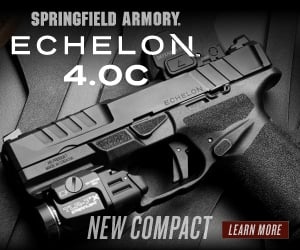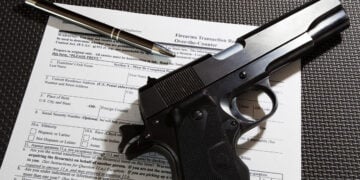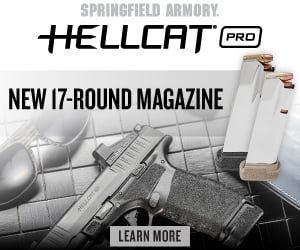This is part 2 of a two-part article about the very important factors and solutions for reducing lead exposure when shooting and handling firearms. Previously, part 1 covered the primary sources for exposure to lead, the significant lead risks and health dangers, the lead exposure limits for adults, children, and gun range workers, the effects of excessive lead on parts of the body, specific concerns for lead exposure when shooting, handling, and cleaning a gun, and symptoms of lead poisoning.
This part 2 addresses blood lead level concerns and research about the effects of gun calibers and related lead hazards, comparisons between indoor and outdoor shooting ranges and lead risks, frangible bullets, and fragmentation, recommended lead-free bullets, primers, and frangible ammo, some manufacturers of non-lead bullets, and my 15 practical tips as solutions for reducing lead exposure and minimizing health hazards.
Questions About Lead Hazards and Guns
Here in part 2 are the questions I have about lead hazards when handling and shooting guns. At the end, I give you my 15 tips as just some possible solutions, plus some non-lead alternatives when shooting.
- What does the research literature say about the effects of gun calibers on lead hazards?
- What about blood lead levels and risk factors for indoor and outdoor gun ranges?
- Do some states and countries require Non-Lead Ammo to be used?
- What are frangible bullets and the factors that increase bullet fragmentation?
- What are some non-toxic and lead-free alternatives for bullets and primers for shooting?
- What are some tips and suggestions for minimizing lead exposure and health hazards?
You should also read the questions and answers from my earlier article, Reducing Lead Exposure from Firearms: Risks and Dangers.
Research Data: Gun Calibers, Indoor & Outdoor Shooting Ranges, and Blood Lead Levels
National Institutes of Health Research: Gun Calibers and Lead in Blood
Interestingly, the National Institutes of Health and the researcher Demmeler in 2009 observed that the higher the caliber of gun shot (9mm and above) versus .22LR caliber, for example, the higher the shooter’s blood lead level. But, there has been no current, in-depth corroborative research about this.
National Institute for Safety and Health Research: Indoor and Outdoor Shooting Ranges
There is some general data that shows shooters at indoor shooting ranges have higher blood lead levels, due to the greater absorption of lead from inhalation compared with ingestion and dermal absorption, according to the National Institutes of Health. There is more open space at outdoor shooting ranges which allows the lead to be more widely dispersed, according to the National Institute for Safety and Health (NIOSH.) But, “despite the natural ventilation of outdoor firing ranges, personal breathing zone lead levels can exceed the NIOSH recommended exposure limit and Occupational Safety and Health Administration (OSHA) permissible exposure limit for lead.” (Mancuso et al. 2008.)
National Institutes of Health Research: Non-Lead and Non-Toxic Ammo Required by Some States and Countries
Non-toxic bullets and shot can be used to prevent the release of lead into the environment. More U.S. manufacturers and those in some other countries are using exotic alloy mixtures like steel, bismuth, and tungsten. Some regulations mandate the use of non-toxic projectiles when hunting, especially when hunting waterfowl. Non-lead non-toxic ammunition is required in California when hunting any wildlife with a firearm, for example. Lead shot for hunting is banned in 23 European countries as of 2019, per Mateo and Kanstrup research with the National Institutes of Health.
There is an awareness that some lead bullet fragments might end up in the hunter’s game meat intended for human consumption. So states are investigating this, and some have published guidelines and laws on how to reduce accidental lead exposure from game meat, especially to children under six years of age and pregnant or nursing women. For example, the states of Colorado, Illinois, Washington, and Nevada have laws requiring non-toxic ammo for hunting ducks, geese, doves, and certain wildlife on public lands and refuges.
Frangible Bullets and Factors that Increase Lead Bullet Fragmentation
When I attended a Sig Sauer Academy training course in Epping, New Hampshire, they required non-toxic, non-jacketed frangible ammo be used. Frangible bullets are designed to fragment and disintegrate into tiny particles upon target impact and to minimize penetration of other objects. Small particles are slowed by air resistance and are less likely to cause injury or damage to unintended persons and objects from bullet impact. Also, because of their brittleness, they are less likely to ricochet from hard targets as larger particles.
Minnesota Research: When Lead Bullets Fragment the Most
A research study by the Minnesota Department of Natural Resources concluded that ammunition type is a key factor in the degree of bullet fragmentation when harvesting wild game. They found that lead bullets fragmented more under the following conditions:
- When the bullet is fired at high velocities (greater than 2,000 feet per second, e.g., rifle bullets);
- When the bullet has a low weight for the respective rifle caliber;
- When the bullet has a fast expansion rate upon impact, e.g., ballistic tip or soft point); and
- When the bullet lacks an encased core that is fused to the outer casing or jacket, e.g., non-bonded bullets.

Non-Toxic, Lead-Free Bullets, Primers, and Frangible Ammo Alternatives for Shooting
There are non-toxic and lead-free ammo alternatives to reduce lead exposure when shooting and handling a gun at shooting ranges and in many activities. Of course, there are the common ways like not shooting in poorly-ventilated ranges, avoiding shooting on days when the wind is blowing toward you, and limiting shooting time on a busy range to minimize exposure to second-hand lead.
Frangible, Lead-Free Ammo is Questionable by Some
Recognize that even though some manufacturers are producing frangible, lead-free, and non-toxic ammo, it is not accepted by some individuals and some locales. Some criticize its accuracy, high cost, and terminal performance, but these are debatable. What is the trade-off with the price of health? Although harder to find now during our Pandemic, it seems somewhat less expensive now than last year, more shooters are aware of its lead-reducing and non-toxic properties, hunters are learning about its high performance, there are new lead-free and frangible products for a wider range of calibers, and more big box stores are stocking it
NOTE: Non-lead frangible bullets retain about 98% of their weight and this is a clear benefit. By keeping close to their original weight, bullets have more ability to accomplish their stopping power, damages, and tasks.
Some Non-Lead Bullet Manufacturers
- SinterFire: Greenline Frangible (pistol); SF45-155 RHHP Concave & Hollow Point (.45 pistol);
- Speer & CCI: Lawman RHT Frangible (pistol); TNT Green; Estate High Velocity Magnum Steel
- Inceptor: RHP Frangible (pistol)
- Hornady: NTX; GMX; Monoflex
- Federal: Premium Barnes Expander (pistol); Vitalshok: Barnes Triple Shock; Vitalshok: Trophy Copper; Power Shok Copper; American Eagle Clean
- Winchester: E-Tip; XP3 Slugs; Razor Back XT; Power Core 95/5
- Remington: Copper Solids; Disintergrator CTF; Copper Solid Sabot Slugs
- Black Hills: Barnes TSX; Barnes Copper Jacket
15 Tips and Suggestions for Reducing Lead Exposure and Health Hazards
Here are my suggestions and tips for minimizing lead risks and health hazards. Hope they help.
- Shoot lead-free, non-toxic bullets, especially if you do high-volume shooting at an indoor range.
- Select ammo with lead-free primers, which replaces lead-sulfuric primer compounds with safer alternatives.
- Ensure that you shoot copper-jacketed ammo, which encapsulates the bullet in a supportive jacket that helps avoid lead atomization during firing. An independent study concluded that using ammo with copper jackets significantly reduces airborne lead levels.
- Avoid poorly-ventilated shooting ranges with little fresh air and poor housekeeping procedures, especially indoor ranges. Some indoor shooting ranges are built with less effective, cost-reducing ventilation systems and may not be that efficient in reducing lead exposure and may not adequately recirculate the air or use fresh air.
- Shoot primarily at outdoor firing ranges, since generally there will be better ventilation and fresh air flow from wind breezes to help dissipate the lead, than at some indoor ranges.
- Send as few shooters downrange as necessary to put up, take down, and score targets, because at the target is where there is a high lead level, especially indoors.
- To help limit lead contamination, carry to the range firing line area just the weapons to be fired, necessary ammo, and limit taking objects, clothing, bags, and extraneous things there. Do not put spent brass in your pockets or in/under your cap or hat.
- Do not linger for extended periods of time at the range, because you are susceptible to increased lead exposure and contamination. This is difficult because ranges are usually places for socializing.
- Do not consume food, beverages, tobacco, gum, or use cosmetics at the shooting range, since lead dust can easily contaminate these items.
- Carry in your range bag and use wipes for removing heavy metal or lead. Wipe down your arms, hands, fingers, face, and nose with them. Some carry antibacterial hand sanitizers or baby wipes made of benzalkonium chloride for cleanup and to remove some germs. But, they may NOT remove lead, according to the Centers for Disease Control and Prevention in 2020. So, hand sanitizers just kill most of the bacteria and do not remove lead. We use a product called D-LEAD wipe towels to wipe down and specifically remove lead. The cost is about $12 for 40 towels.
- After shooting and handling ammo, always wash your hands thoroughly with soapy water to remove any residue, especially before you eat, drink, smoke, or touch your face or mouth. Shower when you get home.
- Change out of your range shooting clothes as soon as possible after shooting to avoid continued lead exposure from the lead that accumulates on them. Be certain to wash your contaminated clothing and separate it from other laundry before it is worn again. Keep your range shoes at the door or in the garage area only for range use and to avoid tracking contaminants into your home.
- If you reload your own ammo or handle spent brass often, make certain you follow prescribed safety precautions lead guidelines.
- Wear nitrile gloves and eye protection when cleaning your firearms and frequently handling ammo. This, of course, is an overall safety measure, but also helps to prevent lead contamination.
- Have your blood lead level checked regularly, especially if you are a high-volume shooter (about 500 rounds or so a month), shoot frequently (e.g., weekly), firearms instructor, competitive shooter, range employee, or have reason to be concerned about your level of lead in your system. Have your medical doctor check your blood lead level if you have any doubt or concern.
Continued Success, my friends, and SAFETY FIRST ALWAYS!
Photos by Author.
Thanks to the following frangible and/or lead-free bullets, primers, and ammo manufacturers for their assistance:
SinterFire
Frangible & Lead-Free Primers, Bullets, and Ammunition
1-814-885-6672
Kersey, PA 15846
Vista Outdoor
Federal, CCI, & Speer Frangible Ammunition
1-800-379-1732
Anoka, MN 55303
Fiocchi
Frangible & Lead-Free Ammunition
1-417-725-4118
Ozark, MO 65721
* This personal opinion article is meant for general information & educational purposes only, and the author strongly recommends that you seek whatsoever.counsel from an attorney for legal advice and your own personal certified weapons trainer for proper guidance about shooting & using YOUR firearms, self-defense and concealed carry. It should not be relied upon as accurate for all shooters & the author assumes no responsibility for anyone’s use of the information and shall not be liable for any improper or incorrect use of the information or any damages or injuries incurred
© 2020 Col Benjamin Findley. All Rights Reserved. This article may not be reprinted or reproduced in whole or in part by mechanical means, photocopying, electronic reproduction, scanning, or any other means without prior written permission. For copyright information, contact Col Ben Findley at [email protected].










